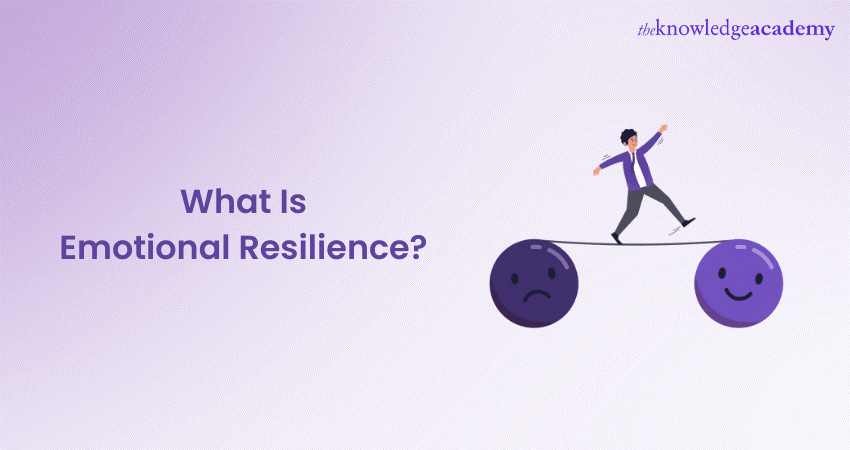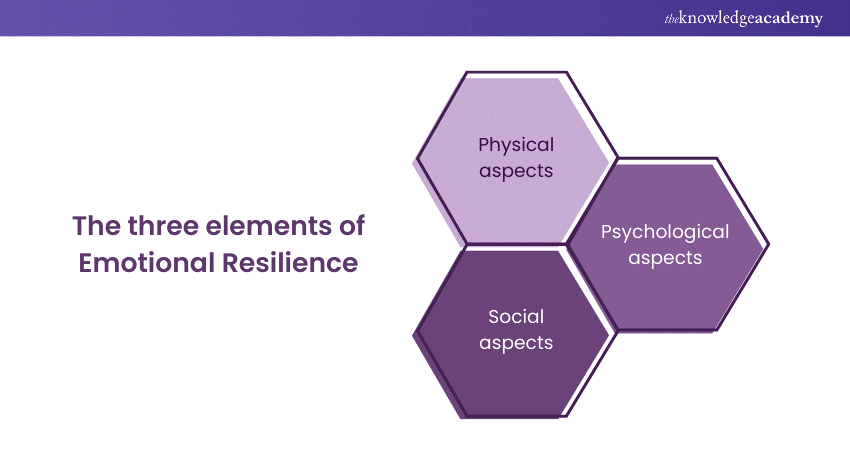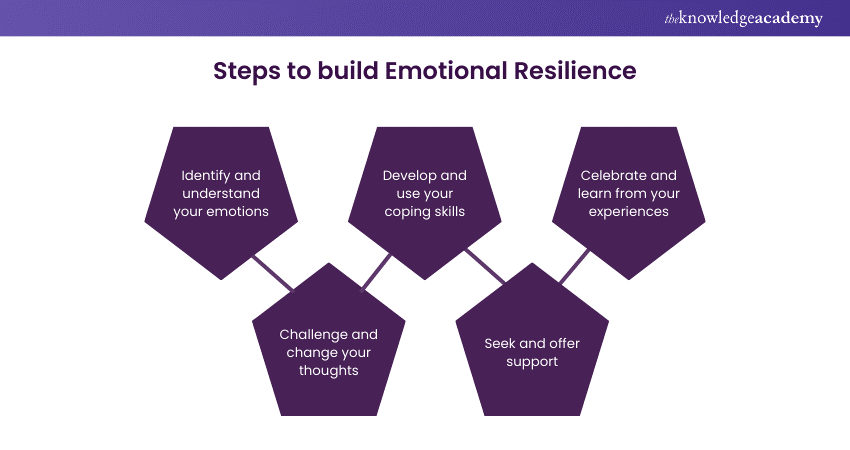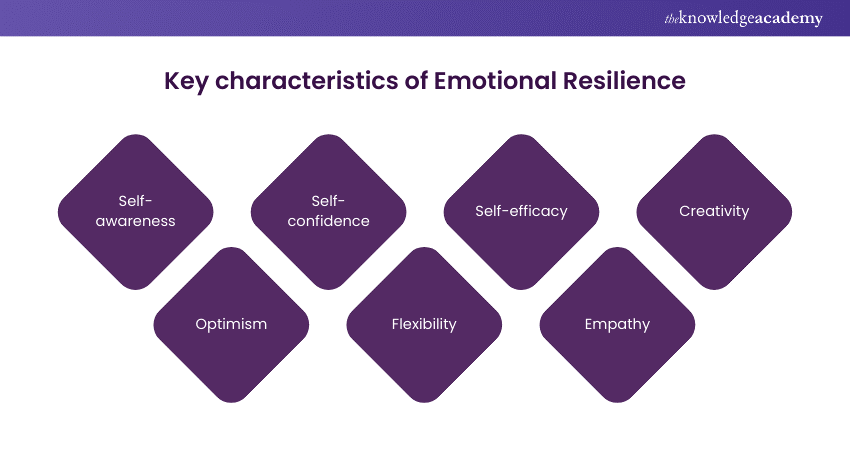We may not have the course you’re looking for. If you enquire or give us a call on 01344203999 and speak to our training experts, we may still be able to help with your training requirements.
Training Outcomes Within Your Budget!
We ensure quality, budget-alignment, and timely delivery by our expert instructors.

When it comes to personal and professional development, navigating stress, adversity, and challenges poses a significant hurdle. At times, it can be overwhelming for you to deal with difficulties like burnout, anxiety, depression, and low self-esteem. Enter Emotional Resilience, a powerful tool for coping with stress and overcoming challenges positively and constructively. But what is Emotional Resilience, and how does it effectively tackle these challenges and how to develop it?
If you are interested in understanding What is Emotional Resilience, its key elements and how to develop it, then this blog is for you. Let's dive in to learn more!
Table of Contents
1) Understanding Emotional Resilience
2) The three elements of Emotional Resilience
3) Steps to build Emotional Resilience
4) Key characteristics of Emotional Resilience
5) Conclusion
Understanding Emotional Resilience
Emotional Resilience is not a trait that we are born with or without. It is a dynamic process that can be influenced by various factors, such as our personality, upbringing, environment, and experiences. Emotional Resilience can also vary depending on the situation and the context. Some people may be more resilient in certain areas than others.
Emotional Resilience is not the same as happiness or optimism. It does not mean we never feel negative emotions or always see the bright side of things. Rather, it means that we can recognise and accept our positive and negative emotions. You can use them as a source of information as well as motivation.
Emotional Resilience also does not mean that we never face challenges or problems. It means that we can deal with them proactively and adaptively without letting them overwhelm or define us.

The three elements of Emotional Resilience
Emotional Resilience consists of three main elements: physical, psychological, and social. These elements are interrelated and influence each other. Let us look at each of them in more detail:

1) Physical aspects
The physical aspects of Emotional Resilience refer to how we take care of our body and health. This includes our diet, exercise, sleep, hygiene, and medical care. A healthy body can support a healthy mind, and vice versa. Besides, physical activity can reduce stress, improve mood and cognitive function, and boost the immune system.
Similarly, getting enough sleep can improve our memory, concentration, creativity, and emotional regulation. On the other hand, deprived physical health can increase our vulnerability to stress and affect our mental well-being.
2) Psychological aspects
The psychological aspects of Emotional Resilience refer to how we think, feel, and behave in response to stress and challenges. This includes our mindset, attitude, beliefs, values, goals, and coping skills. A positive and flexible mindset can help us to see challenges as opportunities rather than threats and to focus on what we can control rather than what we cannot.
A positive attitude can also help us to appreciate what we have rather than what we lack and to express gratitude rather than resentment. A clear and realistic sense of thought can help us to find our strengths and weaknesses and to set achievable and meaningful goals. Various coping skills can help us manage our emotions, solve problems, communicate effectively, and seek help when needed.
3) Social aspects
The social aspects of Emotional Resilience refer to how we relate to others and our environment. This includes our family, friends, colleagues, community, and culture. A strong and supportive social network can provide us with emotional, practical, and informational support, as well as a sense of belonging and identity.
A positive and respectful relationship with ourselves and others can also foster trust, empathy, and cooperation. A diverse and inclusive environment can expose us to different perspectives, experiences, and opportunities and enrich our learning and growth.
Elevate your Emotional Intelligence with our Emotional Intelligence Training – Sign up today!
Steps to build Emotional Resilience
Emotional Resilience is not something that we have or do not have. We can develop and improve it over time through practice and experience. Here are some steps that can help us to build our Emotional Resilience:

Identify and understand your emotions
Fundamental to fostering Emotional Resilience is acknowledging and understanding your emotions and their origins. Regular monitoring of your emotional state can be achieved through methods like journaling, using a mood tracker, or employing a straightforward emotional scale.
Additionally, practices like meditation and breathing exercises can effectively soothe both mind and body, allowing you to observe your emotions impartially and without immediate reaction.
Challenge and change your thoughts
A crucial part of developing Emotional Resilience involves scrutinising and altering any thoughts and beliefs that might contribute to or amplify your stress and discomfort. Techniques like Rational Emotive Behavior Therapy (REBT), Cognitive Behavioral Therapy (CBT) or approaches grounded in positive psychology can be instrumental in this process.
These methods assist in recognising and confronting negative or irrational thought processes, enabling you to substitute them with more constructive and empowering ones.
Develop and use your coping skills
The third step to building Emotional Resilience is to apply and practice your coping skills in different situations and contexts. There are many Ways to Build Resilience with coping skills. You can use strategies such as problem-solving, decision-making, time management, goal-setting, assertiveness, humour, or relaxation to deal with stress and challenges in a constructive and effective way. You can also seek professional help, such as counselling, coaching, or therapy, if you feel that you need more guidance or support.
Seek and offer support
The fourth step to building Emotional Resilience is to reach out and connect with others who can provide you with support, feedback, and encouragement. You can also offer your support, feedback, and encouragement to others who may need it. You can join or create a support group, a peer network, a mentorship program, or a volunteer organisation where you can share your experiences, learn from others, and contribute to a common cause.
Celebrate and learn from your experiences
The fifth and final step to Building Resilience is to acknowledge and appreciate your achievements and progress, as well as your mistakes and setbacks. You can use tools like a gratitude journal, a success log, or a reward system to celebrate your wins and reinforce your positive behaviours.
You can also use tools such as a failure log, a reflection journal, or a feedback loop to learn from your losses and improve your performance.
Master the art of Sentiment Analysis with our Sentiment Analysis Training – Sign up now!
Key characteristics of Emotional Resilience
Emotional resilience is not a single skill or trait but a combination of several characteristics that can help us cope with stress and adversity. Some of the key characteristics of Emotional Resilience are:

a) Self-awareness: Self-awareness is the ability to acknowledge and understand our own emotions, thoughts, behaviours, strengths, weaknesses, values, and goals. Self-awareness helps us monitor and regulate our emotional state, align our actions with our intentions, and adapt to changing circumstances.
b) Optimism: Optimism is the tendency to expect positive results and focus on a situation's positive aspects. Optimism helps us to see opportunities rather than threats, to find solutions rather than problems, and to hope rather than despair.
c) Self-confidence: Self-confidence is the belief in our own capabilities, skills, and potential. Self-confidence helps us trust ourselves, take risks, face challenges, and overcome obstacles.
d) Flexibility: Flexibility is the capability to adapt to varying situations and conditions. Flexibility helps us to cope with uncertainty, ambiguity, and complexity, embrace change and diversity, and learn and grow from new experiences.
e) Self-efficacy: Self-efficacy is the belief in our own capacity to achieve our desired outcomes. Self-efficacy helps us set realistic and meaningful goals, persist in facing difficulties, and recover from failures.
f) Empathy: This skill involves understanding and effectively conveying the emotions and viewpoints of others. Empathy helps us to connect and communicate with others, to build and maintain relationships, and to cooperate and collaborate with others.
g) Creativity: Creativity is the capability to generate and implement novel and useful ideas. Creativity helps us find innovative and original ways to solve problems, overcome challenges, and achieve our goals.
Conclusion
We hope you read and understand everything about Emotional Resilience. It is the skill to cope with adversity and challenges constructively. Following the steps to build Emotional Resilience can enhance our well-being, performance, and happiness.
Learn how to thrive in the face of adversity with our Resilience Training – Sign up now!
Frequently Asked Questions

Emotional Intelligence is our ability to observe, understand, use, and manage emotions in ourselves and others. Emotional Resilience is the ability to overcome stress and challenges positively. Emotional Intelligence is a component of Emotional Resilience, but it is not the only one. Emotional Resilience also involves other factors, such as physical health, psychological skills, social support, and personal characteristics.

Emotional Resilience is not innate but learned. It is influenced by various factors, such as our personality, upbringing, environment, and experiences. However, it is not fixed or predetermined. It can be developed and improved over time through practice and experience. We can learn to be more resilient emotionally by following the steps to build Emotional Resilience and seeking and offering support.

The Knowledge Academy takes global learning to new heights, offering over 30,000 online courses across 490+ locations in 220 countries. This expansive reach ensures accessibility and convenience for learners worldwide.
Alongside our diverse Online Course Catalogue, encompassing 17 major categories, we go the extra mile by providing a plethora of free educational Online Resources like News updates, blogs, videos, webinars, and interview questions. By tailoring learning experiences further, professionals can maximise value with customisable Course Bundles of TKA.

The Knowledge Academy’s Knowledge Pass, a prepaid voucher, adds another layer of flexibility, allowing course bookings over a 12-month period. Join us on a journey where education knows no bounds.

The Knowledge Academy offers various Personal Development Courses, including Resilience, Emotional Intelligence, and many more. These courses cater to different skill levels, providing comprehensive insights into Business Skills methodologies.
Our Business Skills blogs cover a range of topics related to Resilience, offering valuable resources, best practices, and industry insights. Whether you are a beginner or looking to advance your Business Skills, The Knowledge Academy's diverse courses and informative blogs have you covered.
Upcoming Business Skills Resources Batches & Dates
Date
 Resilience Training
Resilience Training
Fri 21st Jun 2024
Fri 30th Aug 2024
Fri 18th Oct 2024
Fri 20th Dec 2024







 Top Rated Course
Top Rated Course


 If you wish to make any changes to your course, please
If you wish to make any changes to your course, please


